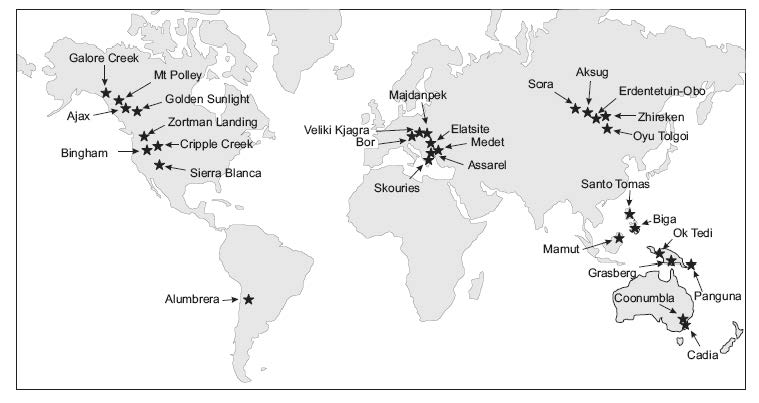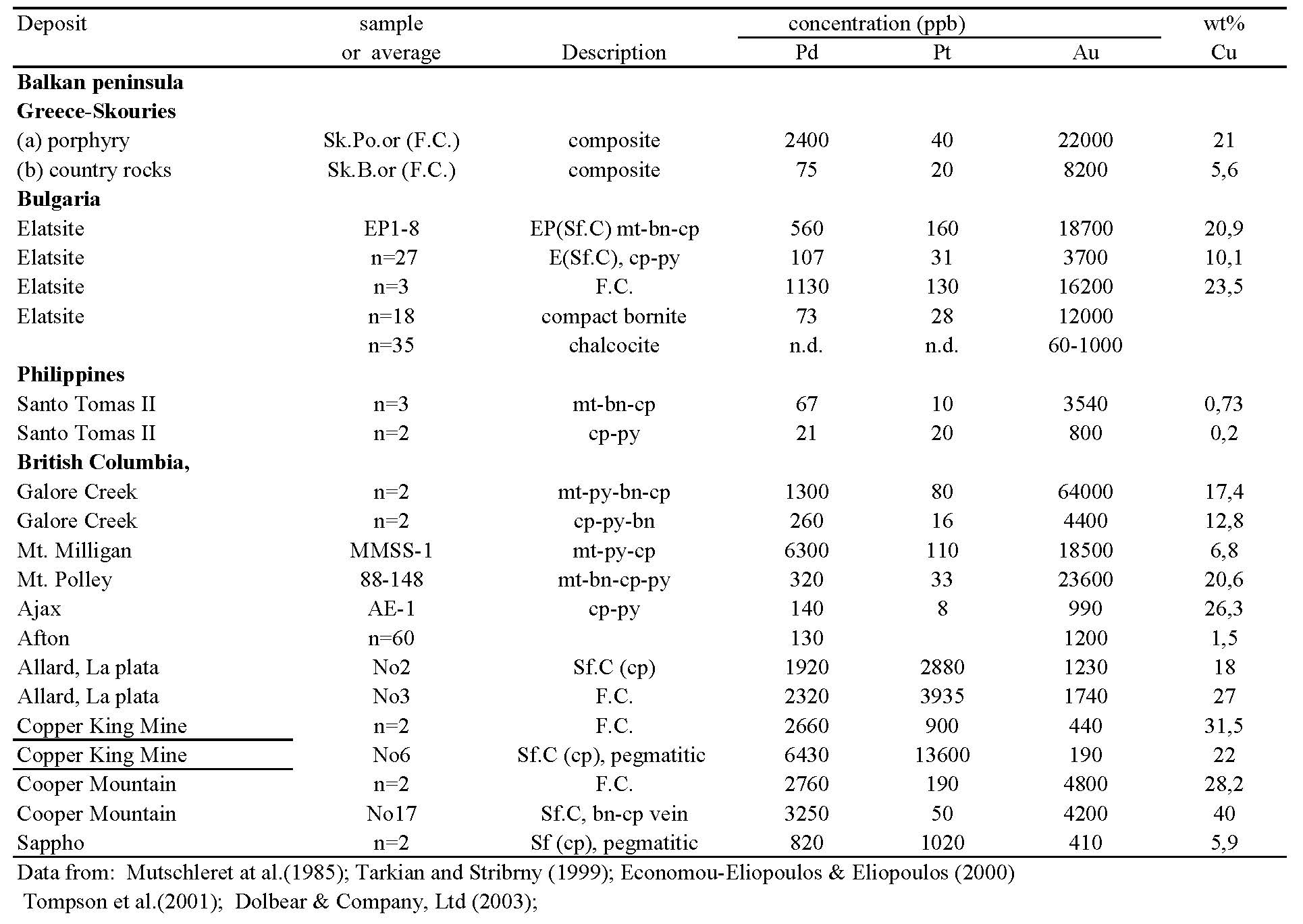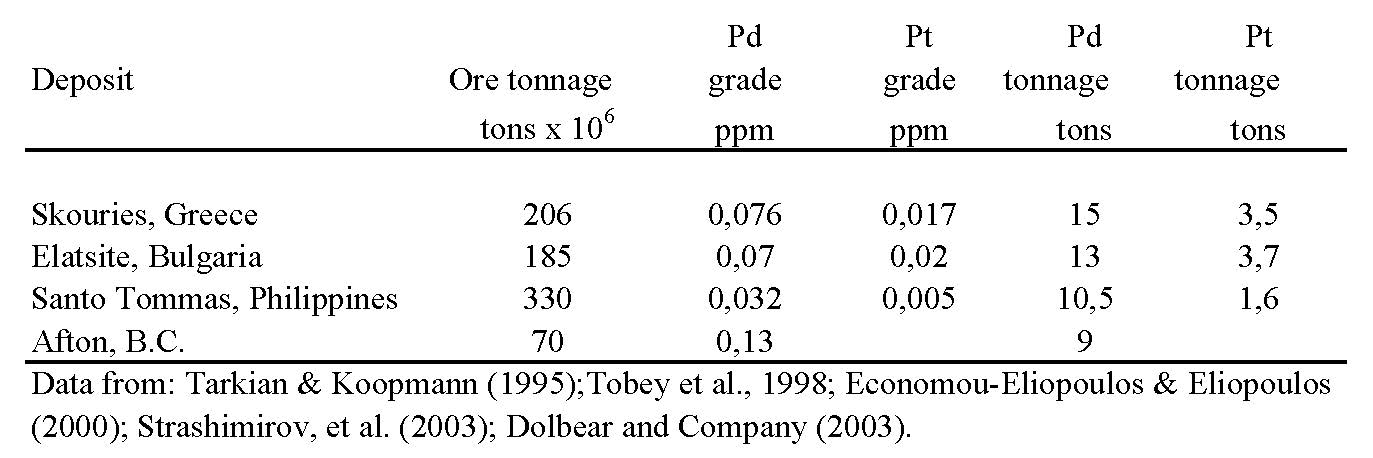PGE mineralization in porphyry-Cu alkaline intrusions
Introduction
Many giant gold-rich porphyry deposits are generated at convergent margins during or following subduction of lithosphere, in an environment, which may vary from compressional to tensional and shearing [Sillitoe 1997, 2000; Müller and Groves 2000]. The majority of giant gold-rich porphyry deposits are located in the circum-Pacific region and they are commonly emplaced at depths of 1–2 km. Differentiated felsic and volatile-rich intrusions may rise to higher crustal levels, along older fault systems, facilitating the intrusion of porphyry stocks or dikes near surface levels [Sillitoe 2000; Sillitoe and Hedenquist 2003]. Parental magmas are considered to be moderately water-rich as indicated by the presence of hydrous minerals (amphibole, biotite), whose stability requires at least 3 wt.% H2O in the melt. Such hydrous melts may contain metals and ligands of critical significance to the formation of Au-rich porphyry deposits [Sillitoe 2000].
Elevated Pd and Pt contents have been described in the Cordillera of British Columbia (Copper Mountain, Galore Creek), Allard Stock, La Plana Mountains and Copper King Mine in USA, Skouries porphyry deposit, Greece, Elatsite, Bulgaria, and from Santo Tomas II in the Philippines [Werle et al. 1984; Mutschler et al. 1985; Eliopoulos and Economou-Eliopoulos 1991; Piestrzynski et al. 1994; Eliopoulos et al. 1995; Tarkian and Koopmann 1995; Tarkian and Stribrny 1999; Economou-Eliopoulos and Eliopoulos 2000; Fig. 9].
Balkan peninsula
Porphyry Cu–(Mo–Au) intrusions located within the metallogenetic belt of the Alpine-Balkan-Carpathian-Dinaride orogenic system (Fig. 9b), of Late Mesozoic to Tertiary age, represent subduction-related magmatism following the change from EW to NS convergence between Africa and Eurasia. Porphyry deposits, extending from Romania to Greece are the most important, and predate the subsequent continental collision and post-collision magmatism. Deposits of Serbia (Majdanpek, Bor and Veliki Krivelj), Bulgaria (ssarel, Elatsite and Medet) and Skouries, Chalkidiki Peninsula in northern Greece belong to the Serbo-Macedonian massif (SMM) [Frei 1995; Heinrich and Neubauer 2002].
Skouries deposit: case history discovery
Geologic framework
The Skouries porphyry Cu–Au deposit, located at the Chalkidiki Peninsula, northern Greece belongs to the SMM. The crystalline basement comprises two lithostratigraphic-tectonic units, the lower Kerdylia Formation and the upper Vertiskos Formation, separated by a NW-striking fault system. The Vertiskos Formation consists of old basement gneiss, amphibolite, schist and marble, Tertiary intrusions, ophiolites (the Therma-Volvi-Gomati). Locations of subvolcanic-porphyritic stocks and volcanic complexes related to porphyry Cu deposits [Kockel et al. 1977; Frei 1995, Tobey et al. 1998; Papanikolaou 1997, 2009] are mainly controlled by deep fracture systems that permitted subvolcanic intrusions to reach higher levels of the crust [Kockel et al. 1977; Frei 1995, Tobey et al. 1998]. Isotope data indicate that subvolcanic-porphyritic stocks such as the Skouries, of Miocene age (18 Ma), are younger than the intrusions of the Serbo-Macedonian massif. The Skouries deposit is related to pipe-like intrusions of subalkaline-alkaline composition, with occasionally inclusions of angular mafic fragments (Fig. 10), extending at surface over an area of approximately 200 m x 200 m. The defined reserves in the porphyry Cu–Au deposit of Skouries are approximately 206 Mt at 0.54 % Cu, and 0.80 ppm Au. Geological data based on recent drilling, provided by TVX Gold Inc Hellas indicated that the Skouries deposit is developed around two related porphyry centers at depths between 650 and 800 m [Tobey et al. 1998]. At least four monzonite porphyries have been described Kroll et al. [2002]. In decreasing age, and increasing degrees of fractionation of the parent magmas, they are: (1) pink monzonite, (2) main monzonite, (3) intra-mineral monzonite, and (4) late-stage porphyry. Highgrade ore is directly associated with the main and intra-mineral monzonite phases. Late-stage monzonite dykes that are barren cut all intrusive phases. The monzonite contains phenocrysts of plagioclase, alkali feldspar and amphibole as well as apatite and titanite microphenocrysts in a fine-grained feldspar-dominated groundmass [Kroll et al. 2002].
Figure 10. Representative drill core sample of the Skouries Main monzonite porphyry.
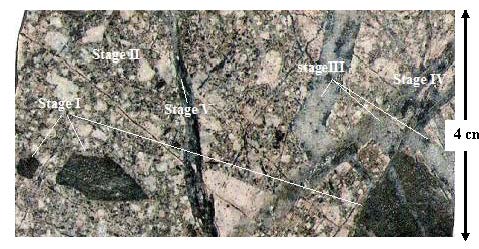
Representative drill core sample of the Skouries Main monzonite porphyry, showing mineralization (disseminated and vein- type) in angular mafic fragments (stage I), pervasive (stage II), crosscutting relationships between successive quartz veins (stages III and IV) dominated by the magnetite-bornite-chalcopyrite assemblage, and a quartz-biotite vein (stage V), reflecting a range of hydrothermal evolution.
Characteristic features of alteration and mineralization
The typical alteration types of the porphyry Cu intrusions described by Lowell and Guilbert [1970] are more or less present in the Skouries intrusion, due to the repeated overprinting and intense silicification, with potassic being the predominant alteration type, whereas the propylitic and surrounding phyllitic alteration are limited in extent. Two mineral assemblages of mineralization, occurring as veinlets/disseminations, can be distinguished: (a) magnetite- (reaching up to 10 vol%, average 6 vol%) bornite-chalcopyrite, linked to pervasive potassic and propylitic alteration type, in the central parts of the deposit, and (b) chalcopyrite-pyrite, which dominates at the peripheral parts of the deposit.
The Skouries deposit is characterized by relatively high Pd and Pt contents (Table 7). Textural relations between Cu-minerals and the main Pd-bearing mineral, merenskyite, and Au-Ag tellurides, indicate that precious metals are closely associated with copper vein-type chalcopyrite or bornite, and are deposited during the earliest stages of alteration and mineralization in the central parts of deposits [Figure 11; Tarkian et al. 1991; Kiousis 2005, 2012]. Magnetite is Cr-bearing (0.65 to 2.26 wt.% Cr2O3 in the matrix to 0.29 wt.% Cr2O3 in magnetite of vein type), in contrast to the Cr-free magnetite of the main porphyry. Chalcopyrite and pyrite contains 0.45 to 2.4 wt.% Ni and 0.64 to 4.18 wt.% Co. Ti-magnetite, with titanium content ranging from 17.5 to 23. 5 wt.%, is commonly associated with rutile, both postdating the main stage of the magnetite deposition. The Skouries porphyry is characterized by high values of the ratios Ce/Lu (<225), relatively high Th and U contents (up to 63 ppm and 9 ppm, respectively), Ba (up to 2260 ppm) and Sr (up to 1230 ppm) contents, reflecting probably a strong fractionation of parental magmas [Eliopoulos and Economou-Eliopoulos 1991].
Figure Table 7. Precious metal content in flotation concentrate (F.C.) and sulphide concentrate (Sf.C) from porphyry-Cu deposits
Figure 11. Intergrowths of Cu-Fe sulfides and precious metal-tellurides, reflecting the association of the Pd-minerals with Cu-concentrates.
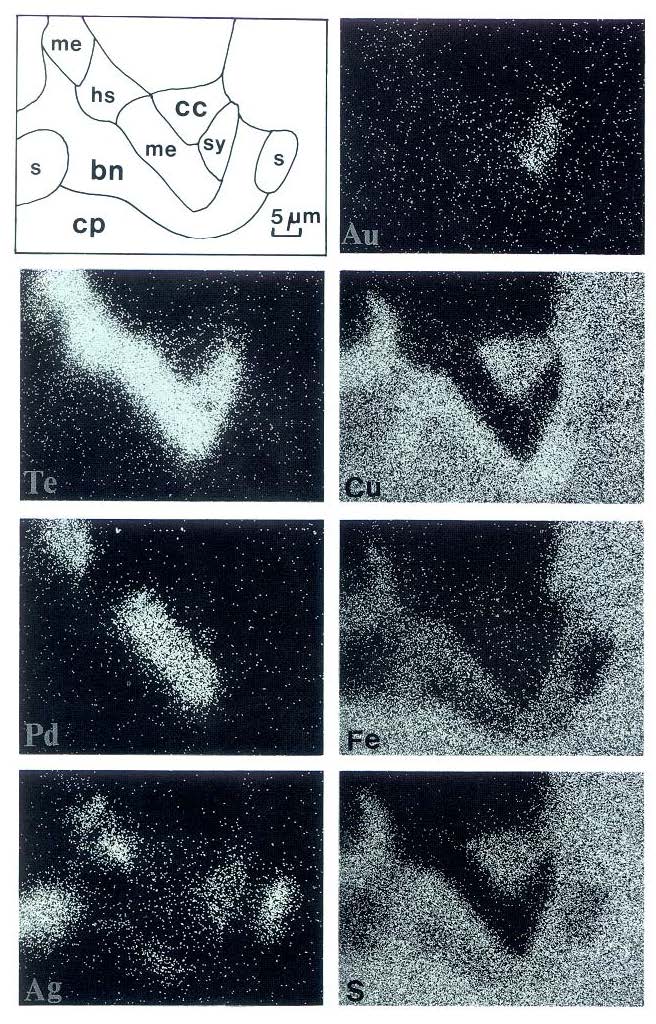
Single element scans (Au, Te, Pd, Ag, Cu, Fe and S) for merenskyite, (me), hessite (hs), sylvanite (sy), stromeyerite (s), bornite (bn), chalcopyrite (cp) and chalcocite (cc) [Tarkian et al. 1991].
The discovery of palladium and its distribution in the Skouries deposit
In the course of a study of slag from prehistoric or Macedonian gold production in Greece, slag from the Skouries porphyry Cu–Au was found to contain a significant Pd content (40 ppb Pd). The subsequent analysis of representative ore samples showed a significant Pd-enrichment in mineralised samples, up to 490 ppb Pd in oxidized ore samples [Eliopoulos and Economou-Eliopoulos 1991]. Subsequently, a more detailed study in the Skouries and other deposits of the Balkan Peninsula was carried out to define relationships between the Pd–Pt and vein-type Cu mineralization, various alteration types or redistribution by leaching from an early-stage. Relatively high Pd content in the major vein-type mineralization of Skouries ranging between 60 and 200 ppb (average 110 ppb Pd), was documented by analysis of a composite drill hole sample (~15 kg) showing 76 ppb Pd and 5000 ppm Cu [Economou-Eliopoulos and Eliopoulos 2000]. Additional analyses of mineralized material and highly mineralized portions from deeper parts of the deposit (from the potassic, propylitic alteration zone) indicated that there is a relatively high palladium, up to 610 ppb (average 130 ppb) and platinum, up to 150 ppb (average 46 ppb) contents [Table 7, Economou-Eliopoulos and Eliopoulos 2001]. Textural relations between base metal sulfides, PGM and Au–Ag tellurides support the association of precious metals with the Cu-minerals (bornite and chalcopyrite), indicating that the main Pd-bearing mineral merenskyite, was deposited during the major stage of Cu deposition. Assuming that Pd is mainly associated with chalcopyrite in porphyry-copper deposits and calculating the measured Pd contents in chalcopyrite (measured contents are normalized to 100 percent chalcopyrite), then the Pd values in the mineralized samples from deeper parts of the Skouries deposit is 3000 ppb Pd. This content is comparable to that in the chalcopyrite concentrate (2400 ppb Pd to 21 wt.%, and Pt content is 1230 ppb [Economou-Eliopoulos and Eliopoulos 2000].
Native gold and electrum may form intergrowths with Pd-Pt-Bi- and Ag-tellurides, ranging from less than 1 to tens of μm [Tarkian et al. 1991; Tarkian and Koopmann 1995; Tarkian and Stribrny 1999; Kesler et al. 2002; Tarkian et al. 2003]. In addition, gold inclusions in chalcopyrite of the magnetite-bornite-chalcopyrite association tend to be poorer in Ag compared to those (electrum) in the chalcopyrite-pyrite assemblages. Subsequent events overprinting early potassic alteration and ore commonly remobilized Cu and Au, resulting in complete destruction of bornite and deposition of new chalcopyrite-pyrite assemblages in which gold is associated with both minerals.
Sources of Metals and Sulfur in Porphyry Copper Deposits
The contribution of mantle, oceanic and continental crust to the parent magmas of porphyry copper intrusions remains still uncertain [Burnham 1979; Burnham and Ohmoto 1980; McInnes and Cameron 1994; Keith et al. 1998; Titley 2001]. Numerous authors have suggested crustal sources for some ore metals in the southern Arizona deposits [Titley 2001]. Evidence from xenoliths, geological, mineralogical, geochemical and isotopic data indicates that the high Pd and Pt mineralization in the porphyry deposits of the British Columbia Cordillera derived probably from an enriched mantle source [McInnes and Cameron 1994]. They may reflect partial melting and incorporation into the melt of destabilized precious metal-bearing Fe–Ni–Cu-sulphides, hosted in the mantle source [Keith et al. 1998; Hattori and Keith 2001]. The occurrence mafic dikes, post-dating the porphyry mineralization at the Elatsite deposit [von Quadt et al. 2002; Strashimirov et al. 2002], and the relatively high Re concentrations (average 1880 ppm) in the molybdenite from main stage stockwork mineralization of the Elatsite Cu–Au deposit, Bulgaria, have been attributed to a direct involvement of mantle in an arc-subduction environment as well [Zimmerman et al. 2003]. Also, the incorporation of mafic material within the crust, prior to the final emplacement of porhyry, is supported by the presence of mafic fragments within porphyry (Fig. 10) and the 87Sr/86Sr and 207Pb/204Pb values [Frei 1995; Sillitoe 2000; Müller and Groves 2000; Sotnikov et al. 2000; Tosdal and Richards 2001; von Quadt et al. 2002]. In addition, the enrichment (hundreds ppm) in compatible elements such as Cr, Co±Ni, that occur in the Skouries, Elatsite, Medet, Assarel and Trar Asen porphyry deposits of the Balkan [Eliopoulos et al.1995; Economou-Eliopoulos 2005], despite their otherwise more evolved geochemical signatures, may indicate a magma mixing with mafic alkaline rocks.
Critical factors for the formation of porphyry Cu+Au+Pd ±Pt deposits
The porphyry Cu±Mo±Au deposits may be developed around single intrusions or within systems that are more complex. Commonly, they are related to multiple and multistage hypabyssal pipe-like intrusions extending at surface over widths ranging from less than 100 m to more than 1 km [Tobey et al. 1998; Müller and Groves 2000; Tosdal and Richards 2001; Kroll et al. 2002]. The wide range of physicochemical conditions and the dynamic interplay between magmatic, hydrothermal and tectonic processes during the formation of porphyry Cu deposits in volcano-plutonic arcs, and the composition of alkaline parent magmas or those of large batholithic bodies underlying at greater depths the porphyry stocks may be major controls of their base/precious metal potential and characteristics. These could include the hydrous and oxidized nature, and their ability to produce hydrothermal systems with ideal chemistry for transporting precious metals. In addition, alkaline magmas are richer in SO2 and CO2 than their calcalkaline counterparts are. Also, volatiles that have a significant influence on fluid pressures, brecciation and permeability of host rocks [Mutschler et al. 1985; Corbett and Leach 1998; Eliopoulos and Economou-Eliopoulos 1991; Eliopoulos et al. 1995; Frei 1995; Tarkian and Koopmann 1995; Sillitoe 2000; Müller and Groves 2000; Sotnikov et al. 2000; Strashimirov et al. 2002].
Porphyry Cu-Au-Pd±Pt deposits in the Karpathian-Balkan system show a similarity in terms of their associations with alkaline rocks, in particular those characterized by (a) SiO2 <65 wt.%, (b) a major contribution by crust material, as is exemplified by the 87Sr/86Sr and 207Pb/204Pb values, (c) their association with alkaline or K-rich calc-alkaline systems, characterized by relatively high of REE, Th and halogen (F, Cl) contents (d) the close association of the Cu-minerals with the main Pd-bearing mineral, merenskyite, and Au–Ag tellurides, (e) the association of the elevated Pd, Pt and Au contents with magnetite-bornite-chalcopyrite assemblages, and the pervasive potassic alteration type at the central parts of the deposits, and (f) the transportation of Cu and precious metals, as chloride complexes, by relatively hot (400 to 700oC) and saline to hypersaline (>70 wt.% NaClequiv) hydrothermal fluids. Thus, critical factors controlling base/precious metal potential of porphyry Cu+Au+Pd±Pt deposits are considered to be the composition of parent magmas (contribution of mantle, oceanic and continental crust) and the physico-chemical conditions during the formation of porphyry Cu deposits. The oxidized nature of parent magmas, as it is exemplified by the abundance of magnetite, may be connected with the ability to produce hydrothermal system with ideal chemistry for transporting precious metal and reflect good exploration target for the precious metals. In contrast, “reduced” porphyry Cu-Au deposits, lacking primary hematite, magnetite, and sulphate minerals (anhydrite), contain abundant pyrrhotite, and are relatively Cu-poor, but Au-rich deposits.
The association, in space and time between porphyry and epithermal deposits may play a major role on the evolution of the whole system and the grade/size of porphyry Cu–Au–Pd–Pt deposits [Werle et al. 1984; Sillitoe 2000; Sillitoe and Hedenquist 2003]. The presence of fluid inclusions hosted by enargite in epithermal deposits, like Chelopech (Bulgaria) and Bor (Serbia), with moderate salinities (4 to 20 wt.% NaCleq), coupled with the common presence of sericitic roots to lithocaps in general, may suggest that the high-sulfidation ore fluids are affiliated with the sericitic stage of underlying porphyry deposits. Moreover, the Ag/Au ratios may be controlled by the metal endowment of the parent magmas rather than the chloride content of the early sulphide-precipitating fluids [Sillitoe and Hedenquist 2003; Taylor et al. 1994; Müller et al. 2003].
Evaluation of Pd and Pt as an economic factor for porphyry Cu–Au systems
Th e potential for PGE mineralization associated with such large Cu and Au-Cu porphyry deposits is still unknown. The Pd-telluride, merenskyite, which is the main PGE mineral in porphyry Cu–Au–Pd–Pt deposits, (Skouries, Elatsite, Medet and Bor/Madjanpek) occurs mostly as inclusions or at margins of chalcopyrite and bornite (Fig. 11). Relatively high Pd contents in the major vein-type mineralization of Skouries (average 110 ppb Pd) was documented by analysis of a composite drill hole sample (~15 kg), showing 76 ppb Pd to 5000 ppm Cu. Assuming that Pd in porphyry Cu deposits is mainly associated with chalcopyrite (measured contents are normalized to 100 % chalcopyrite), then the average Pd and Pt values (from numerous mineralized samples of the Skouries deposit) are 3000 ppb and 1230 ppb, respectively. Using 206 Mt reserves according to data by TVX [Tobey et al. 1998] and average concentrations (0.5 wt.% Cu, 75 ppb Pd and 17 ppb Pt), then the potential of the Skouries deposit is approximately 15 tons Pd and 3.5 tons Pt. Also, using reserves and average Pd and Pt contents the potential is about 13 tons Pd and 3.7 tons Pt for the Elatsite deposit, 10.5 tons Pd and 1.6 tons Pt for the Santo Tomas II, Philippines deposit, and 10.5 tons [Economou-Eliopoulos 2005].
A recovery method was applied on chalcopyrite concentrates from the Skouries and other porphyry Cu-Au deposits [Kiousis et al. 2005; Kiousis 2012] includes two stages: a) oxidizing roasting of the concentrates at 915oC for 2 h and b) oxidizing leaching of the roasted and grained concentrates at 70oC for 24 h. The leaching was carried out in a spherical reactor, that contains a solution of 500 ml HCl 6 M and H2¬O2 0.03 M, under continuous stirring, and the recovery percentage was more than 85%. Furthermore, based on data from Behre Dolbear and Kvaerner Metals feasibility studies a technico-economical analysis was carried out, and the estimated of the Net Present Value (N.P.V.) was given [Kiousis and Papavasiliou 2005]. The capacity of a magmatic hydrothermal system in precious metals and the possibility to form economic deposits, combined with the obtained data of the technico-economical approach suggest that the recovery of Pd and Pt, as by-products, the Cu and Au being the main products, may contribute significantly to a N.P.V. increase and improves the economic attractiveness for certain porphyry-Cu deposits.
